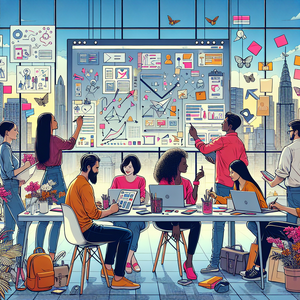The Art of Storytelling in UX/UI Design

Storytelling is a fundamental part of human communication. It resonates with our emotions, helps us remember information, and fosters connections. When applied to UX/UI design, storytelling can create an emotional bond between the user and the product, transforming the user experience from a mere interaction to a meaningful journey. For instance, consider a travel app. Rather than simply presenting flight options, the app could narrate a story about the adventures that await the user at their destination. By weaving in personal anecdotes, experiences, or user-generated content, the app becomes more than just a tool; it becomes a portal to experiences, igniting the user's imagination and desire to explore.
Techniques for Integrating Storytelling
Understanding users’ needs, motivations, and pain points is crucial. By developing detailed user personas and scenarios, designers can craft experiences that resonate deeply with their target audience. For example, a fitness app could create user personas for different fitness levels and goals, allowing designers to tailor the story of the user’s journey to match their specific aspirations. This ensures that each user feels personally connected to the narrative, increasing their engagement with the app.
Visual Narrative
The visual elements of a design can tell a story just as effectively as words. Designers can use imagery, color schemes, and typography to evoke emotions and convey messages. For instance, a sustainability-focused brand could utilize earthy tones and organic shapes to create a narrative of environmental consciousness and responsibility, reinforcing the brand's commitment to nature. The visual narrative not only enhances the aesthetic appeal but also aligns with the brand’s values, creating a cohesive user experience.
Micro-Interactions
These small design elements can enhance storytelling by providing context and feedback. For instance, when a user completes an action, a subtle animation can illustrate the positive outcome of that action, like a progress bar filling up or a small celebration animation. This not only adds a layer of storytelling but also makes the user feel accomplished. Micro-interactions can serve as a narrative device, reinforcing the idea that each action contributes to a larger story.
Sequential Design
Arranging content in a way that encourages exploration can create a narrative flow. By guiding users through a logical progression of information, designers can lead them on a journey that reveals insights and builds anticipation. For example, an online learning platform can structure courses in a way that each lesson builds upon the last, creating a cohesive narrative that enhances the learning experience. This sequential approach not only makes the experience more engaging but also helps users retain information more effectively.
Supporting Examples
Numerous brands have successfully leveraged storytelling in their UX/UI design to enhance user engagement. Take Airbnb, for example. Their platform doesn't just list properties; it tells stories about the hosts, the neighborhoods, and the experiences available. Each listing includes personal anecdotes and localized insights that engage users on an emotional level, encouraging them to envision their stay. This approach humanizes the brand and fosters a deeper connection with potential guests. Similarly, Duolingo, a language-learning app, incorporates storytelling into its gamified experience. Users progress through levels that feel like a narrative journey, complete with characters and challenges that add context and motivation to the learning process. This approach not only makes learning enjoyable but also fosters user loyalty, as users feel invested in their journey to learn a new language.
Incorporating storytelling into UX/UI design is not just a trend; it is a transformative approach that can significantly impact user engagement and retention. By understanding the power of narratives and employing techniques such as user personas, visual storytelling, micro-interactions, and sequential design, designers can create meaningful experiences that resonate with users. As the digital landscape continues to evolve, the ability to craft compelling stories within design will be a key differentiator in creating memorable and effective user experiences. Ultimately, storytelling in UX/UI design is about more than just aesthetics—it's about connecting with users on a deeper level and enhancing their journey through the digital world. By embracing the art of storytelling, designers can unlock new opportunities for engagement, retention, and ultimately, success in their projects.
UX Researcher
Google, Adobe, Airbnb
Responsibilities
Conduct user interviews and surveys to gather insights on user behavior and preferences, shaping the design narrative.
Develop user personas and journey maps that encapsulate the emotional and functional aspects of user interactions.
Collaborate with cross-functional teams to ensure research findings inform design decisions and storytelling elements.
Qualifications
A background in psychology or anthropology is beneficial.
UI Designer with a Focus on Visual Storytelling
tech firms, e-commerce platforms, creative agencies
Responsibilities
Create visually compelling interfaces that communicate brand narratives through color, typography, and imagery.
Develop design systems that ensure consistency in storytelling across multiple platforms and devices.
Test and iterate on visual designs based on user feedback to enhance narrative engagement.
Qualifications
Proficiency in design tools such as Sketch or Figma is essential.
Content Strategist for Digital Products
startups, media companies, online retailers
Responsibilities
Craft engaging content that aligns with user journeys, enhancing the storytelling aspect of UX/UI design.
Collaborate with UX teams to ensure content is integrated seamlessly into design, enhancing user experience and retention.
Analyze user data to refine content strategies and ensure narratives resonate with target audiences.
Qualifications
Strong writing skills and experience with SEO practices are crucial.
Interaction Designer Specializing in Micro-Interactions
tech companies, mobile app developers, gaming studios
Responsibilities
Design and prototype micro-interactions that enhance user engagement and provide feedback within the narrative flow of applications.
Collaborate with UX researchers to understand user needs and behaviors, informing the design of interactions that tell a story.
Use animation and design principles to create engaging and intuitive experiences that guide users through their journey.
Qualifications
A strong understanding of animation tools and coding basics can be advantageous.
Product Designer with a Narrative Focus
SaaS companies, fintech startups, e-commerce businesses
Responsibilities
Lead the end-to-end design process, integrating storytelling to create compelling user journeys for digital products.
Work closely with stakeholders to define product vision and user experiences that reflect brand values and user expectations.
Utilize prototyping and user testing to validate design decisions and storytelling elements, ensuring alignment with user needs.
Qualifications
Experience with Agile methodologies and a portfolio showcasing narrative-driven design projects are often required.


